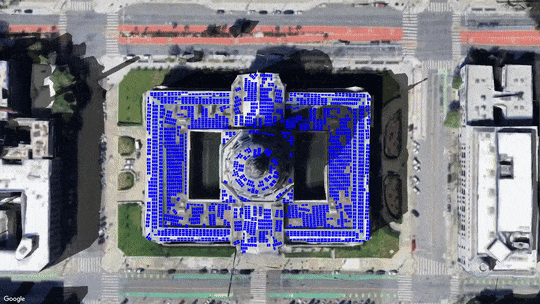Introduction
Estimating solar potential isn’t just about mapping rooftops—it requires accurate panel placement, shading analysis, and real-time sun exposure calculations. To achieve this, we integrated Google’s Photorealistic 3D Tiles with Deck.gl’s Tiles3DLayer and Three.js for rendering dynamically placed solar panels.
While Deck.gl provides high-performance geospatial visualization, Three.js gives us precise control over materials, object transformations, and real-time shadows. Combining both frameworks allowed us to create an efficient, interactive 3D solar analysis tool.
Loading Google 3D Tiles with Deck.gl’s Tiles3DLayer
To render Google’s Photorealistic 3D Tiles, we used Deck.gl’s Tiles3DLayer, which efficiently loads 3D tilesets streamed from Google Maps. These tiles provide:
- True-to-scale building heights and orientations
- Optimized streaming for large urban datasets
- High-resolution rooftop textures for precise visualization
Implementation in Deck.gl
We utilized Tiles3DLayer to load and visualize Google’s 3D Tiles in Deck.gl:
import { Tile3DLayer } from '@deck.gl/geo-layers';
const tiles3DLayer = new Tile3DLayer({
id: '3d-tiles',
data: 'https://tile.googleapis.com/v1/3dtiles/root.json?key=YOUR_API_KEY',
loader: Tiles3DLoader,
onTilesetLoad: (tileset) => {
console.log('Tileset loaded:', tileset);
},
pickable: true,
pointSize: 2
});
new Deck({
layers: [tiles3DLayer]
});
This efficiently streams 3D city models, ensuring smooth performance while loading urban datasets dynamically.
Integrating Three.js and Deck.gl with Google Maps
While Deck.gl handles tile streaming, Three.js is used to dynamically place solar panels on rooftops. To align both rendering systems, we integrated Deck.gl’s camera system with Three.js using GoogleMapsOverlay and Google Maps’ Three.js library.
Synchronizing Camera Systems
To ensure seamless rendering, we synchronized the Google Maps camera, Deck.gl’s Tiles3DLayer, and Three.js:
import { GoogleMapsOverlay } from '@deck.gl/google-maps';
import { WebGLRenderer, PerspectiveCamera } from 'three';
const map = new google.maps.Map(document.getElementById('map'), {
center: { lat: 37.7749, lng: -122.4194 },
zoom: 16,
tilt: 45,
mapId: 'YOUR_MAP_ID'
});
const overlay = new GoogleMapsOverlay({ layers: [tiles3DLayer] });
map.overlayMapTypes.push(overlay);
const threeRenderer = new WebGLRenderer();
const threeCamera = new PerspectiveCamera();
By syncing the Google Maps camera with Three.js, solar panels align perfectly with the real-world buildings in Google’s 3D Tiles.

Enumerating Solar Panel Orientation and Rendering
Instead of procedurally placing panels, we used Google’s Solar API to retrieve panel locations and orientations. We then passed this data to Three.js’s InstancedMesh, ensuring that panels align correctly with rooftops.
Extracting Panel Orientation Data
let pitch = roofseg.pitchDegrees * Math.PI / 180;
let azimuth = roofseg.azimuthDegrees * Math.PI / 180;
Applying Orientation to InstancedMesh
dummy.rotation.z = Math.PI - azimuth;
dummy.rotation.x = pitch * Math.cos(dummy.rotation.z);
dummy.rotation.y = pitch * Math.sin(dummy.rotation.z);
dummy.updateMatrix();
mesh.setMatrixAt(i, dummy.matrix);
To explain the mathematics behind this, we use two rotation matrices:
$$ R_z(\theta) = \begin{bmatrix} \cos\theta & -\sin\theta & 0 \\ \sin\theta & \cos\theta & 0 \\ 0 & 0 & 1 \end{bmatrix} $$
$$ R_x(\phi) = \begin{bmatrix} 1 & 0 & 0 \\ 0 & \cos\phi & -\sin\phi \\ 0 & \sin\phi & \cos\phi \end{bmatrix} $$
Here, $( R_z(\theta) )$ rotates the panel about the vertical axis (adjusting for azimuth), while $( R_x(\phi) )$ rotates it about the horizontal axis to match the rooftop’s pitch. This combination ensures each solar panel is oriented correctly.
Using InstancedMesh for Mass Rendering
Instead of creating separate mesh objects, we used InstancedMesh to render thousands of identical solar panels with a single draw call. Normally, rendering thousands of individual objects would lead to performance bottlenecks due to excessive draw calls. InstancedMesh allows us to batch-render multiple identical objects efficiently by sharing the same geometry and material, significantly improving performance.
const panelGeometry = new THREE.BoxGeometry(1.50, 0.842, 0.1);
const panelMaterial = new THREE.MeshPhongMaterial({ color: 0x000080, shininess: 100 });
const panelMesh = new THREE.InstancedMesh(panelGeometry, panelMaterial, maxArrayPanelsCount);
overlay.scene.add(panelMesh);
BoxGeometry(1.50, 0.842, 0.1) – Defines the size of the solar panel in meters.MeshPhongMaterial– Uses Phong shading to provide realistic lighting effects on the panels.InstancedMesh– Creates a single instance of the panel geometry but renders it multiple times efficiently.maxArrayPanelsCount– Specifies the maximum number of solar panels to be rendered in the scene.scene.add(panelMesh)– Adds the instanced mesh to the Three.js scene.
By using InstancedMesh, we significantly reduce GPU overhead and improve rendering speed, making large-scale urban solar mapping feasible in real time.
Optimizing Tile Rendering with Tileset3D
To prevent unnecessary tile reloading and enhance rendering performance, we optimized Deck.gl’s Tile3DLayer settings. Without these optimizations, the application would waste resources by frequently unloading and reloading 3D tiles, leading to unnecessary network requests and reduced frame rates.
tileset3d.options.unloadTiles = false;
tileset3d.options.refreshTiles = false;
tileset3d.options.preloadTiles = true;
tileset3d.options.viewDistanceScale = 3;
tileset3d.options.maximumMemoryUsage = 512;
tileset3d.options.refinementStrategy = 'REPLACE';
unloadTiles= false – Keeps previously loaded tiles in memory instead of unloading them when they go out of view.refreshTiles= false – Prevents unnecessary tile reloading, improving rendering efficiency.preloadTiles= true – Loads tiles in advance, reducing latency when navigating the 3D scene.viewDistanceScale= 3 – Controls how far tiles should be loaded around the camera view, ensuring that tiles are available when needed without overloading memory.maximumMemoryUsage= 512 – Allocates up to 512MB of memory for tile caching, preventing excessive memory use while maintaining performance.refinementStrategy‘REPLACE’ – Ensures that higher-detail tiles replace lower-detail tiles smoothly without rendering glitches.
Conclusion
By integrating Google 3D Tiles, Deck.gl, and Three.js, we created an efficient system for visualizing rooftop solar potential.
- Deck.gl’s Tiles3DLayer handled seamless 3D tile streaming.
- Three.js provided precise rendering for dynamically placed solar panels.
- InstancedMesh and tile optimizations ensured smooth performance.
Citation
@article{CustomShader,
title = "3D Solar Rooftop Mapping with Google 3D Tiles, Deck.gl, and Three.js",
author = "Atharva Garole | Prathamesh Badgujar | Sagar Singh",
journal = "solar-vortex.github.io",
year = "2025",
month = "February",
url = "https://solar-vortex.github.io/blog/post/blog2/"
}
